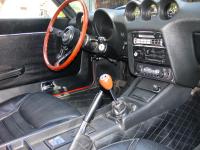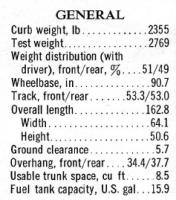Everything posted by Arne
-
what is the TRUE definition of "Series 1"
Will, if that's the impression that came across, I worded it poorly. My point was that the Series 1 and 2 tags are useful here in the USA because of the ambiguous nature of the changes related to the model and titled years. A '71 could be either Series 1 or 2. But all '72s are (theoretically) the same, as all '73s are (theoretically) the same. So when speaking of a '72 or '73 240Z, it is simplest to call it a '72 or '73, and not cloud the issue with "Series" references that not all will understand or agree with.I have no issues with any 240Z, when I first started looking for an S30, I decided that I wanted small bumpers. So I seriously considered all years of 240Zs, and even a couple of early 260Zs. Sure, the earliest cars are more "collectible" but since I wanted a driver that didn't mean much to me. It was simply chance that the one I first bought turned out to be a Series 1. The fact that it was a Series 1 had no bearing on the purchase. Actually, I seldom refer to my cars by Series anywhere but here. When talking to other car people - even other Z people - I typically refer to the yellow car as an "early '71" and the red one as a "late '71". Some people frequently refer to all Series 1 cars as '70 240Zs, regardless of the titled year. Seems to make sense, and could reduce confusion if EVERYONE did that. Most people understand that model-year terminology.
-
what is the TRUE definition of "Series 1"
Stephen, I recall seeing that the clear glass was the norm for the first 1400 cars or so, after which they all got the vertical lines through mid-'72 or '73.
-
what is the TRUE definition of "Series 1"
The lighter was next to the ashtray on both Series 1 and Series 2 cars (US terminology). Basically any '69-71 model year 240Z. The attached picture is of my Series 2, which is a rather late '71 (7/71). The ashtray and lighter both moved for the '72 model year.As an aside, I seldom think in terms of a Series 3 or 4 240Z. I normally think of Series 1 as the original, Series 2 as the later '71s, and then the '72 and '73 model years as separate entities. Another way to look at it is to consider all of what we call Series 1 cars as '70 models (regardless of title year), Series 2's as '71s, etc...
-
what is the TRUE definition of "Series 1"
Dave, here's another link, it gives Nissan's "official" list of the changes from Series 1 to Series 2 in the US. http://zhome.com/History/New71Late.htm
-
what is the TRUE definition of "Series 1"
Dave, my understanding is that the Series 1 are the cars with the hatch vents, which were the first 20,000 or so US cars. The Series 2 cars started production in early Jan. 1971. So most Series 1 cars were BUILT in 1970, with a few in '69 and even fewer in early Jan. '71. About half were probably sold and titled as '71s. In short, if it was built in 1970, it's a Series 1, even if it is titled as a '71. Here's a link from ZHome.com that goes into greater detail: http://zhome.com/History/1970or1971.html
-
Scarab Research
Hmm, my R&T library goes back to '77 or so. I should have that one. I'll have to dig it out.
-
Is this a Series 1 Part?
I vote for the rogue part thing. I've not seen anything like it on the cars I've looked at. But there's probably lots I've never seen yet...
-
Compression 71 240
Randy, the fact that the compression goes up (even a little) wet is normally a good indicator of ring problems. Whether sticky, broken or whatever. You might try simply pulling the head first to take a visual look at the bore, but if the rings are sticky you may not be able to see much.
-
2 Quick SU swap questions...
If you see a deal on a backplate only for an oval one, I've got a spare front housing for one I'd sell cheap.
-
Throwout Bearing - Type "A" and Type "B" Trannys and Problems
If the clutch operated correctly before the teardown, I'd be strongly inclined to continue to use the collar that I knew worked with the clutch cover that you now have. Trying to second guess it when you already have a combo that works sounds like a potential problem to me.
-
2 Quick SU swap questions...
Looks fairly complete, to me. And being that they are supposed to be from a '72 and therefore are (probably) 3-screw carbs with water passages, you would not actually have to change out the entire manifold. The '72 carbs with their center linkage should bolt straight onto your existing '73 manifolds. In fact, some believe that the '73 manifolds flow better, and prefer them over the '72 E88 castings. I think the '72 balance tube will bolt up to the '73 manifolds if you prefer the less complex look of that. Or you can swap the whole enchilada. Re: fuel rail - I believe that all '70-72 rails are the same, so any of them should work. But lots of people run round-tops on '73s using the original '73 fuel rail. Perhaps not quite as clean looking, but functional. So that's not a critical issue. Re: air box - Get an oval one from a '70-72, not the later odd-shaped one from the flat-top cars. The flat-top air cleaner will require adapters from Z Therapy (or some custom work on your own) to fit the round-tops. The adapters aren't cheap, and if you're going to have to buy an airbox anyway, better to get one that fits correctly from the start.
-
Question..??? original carbs or replaced..pic included
No, the pictures you posted in a different thread show the fuel rail and air cleaner as the later flat-top types. So your car has been swapped over.
-
Ebay madness "One of 50 in this special run series"
Big sigh....
-
1971 240z fuel tank size
-
Interesting White LED
Dave, did you use the wide-angle white LED with the factory green lenses? That worked OK?
-
fuse guide?
Changing the fusebox is easy, pretty much as you said. But I'm not yet convinced that you need to do so. If the fusebox is really bad, the problem is very visible even from the front side. At this point, from what you describe, and considering prior history, I'd suspect the combo switch (headlight/wipers) is bad.
-
What exactly am I missing here?
If you're not required to smog the car where you live, I'd not worry about it.
-
What exactly am I missing here?
EGR stuff. Yes, it's emissions-related. Does your car have a header on it? That's a common reason for removal of the EGR.
-
Brake warning light
Oh so very true...
-
Valve cover differences
Actually, it was in this very same thread, on page two. Here's a link to the picture, they apparently did say "Nissan 2000 OHC".http://classiczcars.com/forums/attachment.php?attachmentid=11621&d=1143315711
-
Brake warning light
The parts CD is not conclusive, but makes it sound as though the '77s should still have the switch. It is listed as 46100-N4200, ASSY - SWITCH BRAKE INDICATOR, start date 08/76. No end date is listed. So Ron, I guess my final thought on this then would be to see if your car has a single wire connecting to the distribution block under the master cylinder that all the brake pipes connect to. If it does, I'm going to bet that it has tripped. If it doesn't have that part, check the fluid levels and the switches in the master cylinder caps.
-
Brake warning light
Stephen, you may be right. But I've seen info that stated the switches in the caps started in '78, while the pressure-type switch was used from '70-77. Since the original poster says his car is a '77, my info may still be valid. Or not, as I can't swear to it, and don't have access to a '77 280Z to check.
-
Brake warning light
Stephen, there is also a pressure differential switch on the distribution block under the master cylinder. The switch has a single wire to it. It will light if there is a significant difference in fluid pressure between the front and rear circuits. I'm not sure about our Datsuns, but on some cars once that switch has been tripped, you have to relieve pressure in the other circuit while pressing on the pedal to "re-center" it. This is assuming that the root cause has been repaired, of course.
-
Brake warning light
First question: Did you determine why the front reservoir went empty? Your brakes are a sealed system, and brake fluid doesn't go anywhere. Especially so for the front reservoir of a 280Z, which supplies the rear brakes. Simply filling and bleeding will not fix the root cause - you need to determine where the fluid went. In this case, the warning light may still be trying to tell you something is still wrong. On the other hand, if you have already truly remedied the root problem, you may need to bleed and reset the warning light switch in the distribution block under the master cylinder. I don't know the exact procedure for this on your 280Z, my FSM only covers '70-71 240Z.
-
fuse guide?
And here's what I had to go through to fix the damage after one of my 240Zs' fusebox melted.http://www.classiczcars.com/forums/showthread.php?t=19793 You'll want to check your fusebox's condition carefully. If the rivets between the wires and the fuse holders are at all loose, you may want to consider replacing the fusebox. If you do that, consider getting one of the modern replacement fuseboxes from MSA - http://www.thezstore.com/page/TZS/CTGY/SEIC19. Once replaced, your car would then use the modern colored fuses.






